Application of Levan-Rich Digestate Extract in the Production of Safe-to-Use and Functional Natural Body Wash Cosmetics
Abstract
:1. Introduction
2. Results and Discussion
2.1. The Optimization of the Fermentation Process Focused on Obtaining Ferment Rich in Levan, Polymer and Divalent Metals Ions
2.2. Antimicrobial Activity of Ferment Rich in Levan
2.3. Development of Formulations and Technologies to Obtain Shower Gels Containing Digestate Extract
2.4. Safety Assessment of the Shower Gels
2.5. Evaluation of Functional Properties
3. Materials and Methods
3.1. Raw Materials for Cosmetics
3.2. Fermentation Process for Levan Production with Bacillus Subtilis Natto KB1
3.3. Bacillus-Fermented Supernatant Analysis
3.3.1. NMR analysis
3.3.2. Fourier-Transform Infrared Analysis
3.3.3. Determination of Levan Content
3.3.4. ICP–OES Analysis
3.4. Conductivity Measurements
3.5. Antimicrobial Activity
3.5.1. Agar Well Diffusion Test
3.5.2. Minimum Inhibitory Concentration (MIC) Determination
3.5.3. Effect of Bacillus-fermented Supernatant on Pathogen Cell Shape—Scanning Electron Microscopy (SEM)
3.5.4. Effect of Bacillus-fermented Supernatant on Pathogenic Strain Biofilm Formation
3.5.5. Pre-adhesion Activity of Bacillus-Fermented Supernatant
3.6. Zein Test
3.7. pH Rise Test with Bovine Albumin Serum (BSA)
3.8. Evaluation of Ability to Emulsify Fatty Soils
3.9. Evaluation of Foaming Properties
3.10. Evaluation of Detergent Properties
3.11. Rheological Properties
3.12. Determination of the Color Parameters
4. Conclusions
Author Contributions
Funding
Institutional Review Board Statement
Informed Consent Statement
Data Availability Statement
Conflicts of Interest
References
- Seweryn, A.; Bujak, T. Application of anionic phosphorus derivatives of alkyl polyglucosides for the production of sustainable and mild body wash cosmetics. ACS Sustain. Chem. Eng. 2018, 6, 17294–17301. [Google Scholar] [CrossRef]
- Bujak, T.; Nizioł-Łukaszewska, Z.; Ziemlewska, A. Amphiphilic cationic polymers as effective substances improving the safety of use of body wash gels. Int. J. Biol. Macromol. 2020, 147, 973–979. [Google Scholar] [CrossRef] [PubMed]
- Amberg, N.; Fogarassy, C. Green consumer behavior in the cosmetics market. Resources 2019, 8, 137. [Google Scholar] [CrossRef] [Green Version]
- Nizioł-Łukaszewska, Z.; Osika, P.; Wasilewski, T.; Bujak, T. Hydrophilic dogwood extracts as materials for reducing the skin irritation potential of body wash cosmetics. Molecules 2017, 22, 320. [Google Scholar] [CrossRef]
- Sivamaruthi, B.S.; Chaiyasut, C.; Kesika, P. Cosmeceutical importance of fermented plant extracts: A short review. Int. J. Appl. Pharm. 2018, 10, 31–34. [Google Scholar] [CrossRef]
- Nizioł-Łukaszewska, Z.; Ziemlewska, A.; Bujak, T.; Zagórska-Dziok, M.; Zarębska, M.; Hordyjewicz-Baran, Z.; Wasilewski, T. Effect of Fermentation Time on Antioxidant and Anti-Ageing Properties of Green Coffee Kombucha Ferments. Molecules 2020, 25, 5394. [Google Scholar] [CrossRef]
- Vecino, X.; Cruz, J.M.; Moldes, A.B.; Rodrigues, L.R. Biosurfactants in cosmetic formulations: Trends and challenges. Crit. Rev. Biotechnol. 2017, 37, 911–923. [Google Scholar] [CrossRef]
- Varvaresou, A.; Iakovou, K. Biosurfactants in cosmetics and biopharmaceuticals. Lett. Appl. Microbiol. 2015, 61, 214–223. [Google Scholar] [CrossRef]
- Seweryn, A. Interactions between surfactants and the skin—Theory and practice. Adv. Colloid Interface Sci. 2018, 256, 242–255. [Google Scholar] [CrossRef]
- Klimaszewska, E.; Seweryn, A.; Czerwonka, D.; Piotrowska, U.; Ogorzalek, M. Improvement of the safety in use of babies cosmetics through appropriate selection of surfactants. Przem. Chem. 2017, 96, 2509–2513. [Google Scholar] [CrossRef]
- Jackson, C.T.; Paye, M.; Maibach, H. Mechanism of Skin Irritation by Surfactants and Anti-Irritants for Surfactants Base Products. In Handbook of Cosmetic Science and Technology, 4th ed.; Barel, A., Paye, M., Maibach, H., Eds.; CRC Press Taylor & Francis Group: Boca Raton, FL, USA, 2014; pp. 353–365. [Google Scholar]
- Bujak, T.; Wasilewski, T.; Nizioł-Łukaszewska, Z. Effect of molecular weight of polyvinylpyrrolidone on the skin irritation potential and properties of body wash cosmetics in the coacervate form. Pure Appl. Chem. 2019, 91, 1521–1532. [Google Scholar] [CrossRef]
- Seweryn, A.; Wasilewski, T.; Bujak, T. Effect of salt on the manufacturing and properties of hand dishwashing liquids in the coacervate form. Ind. Eng. Chem. Res. 2016, 55, 1134–1141. [Google Scholar] [CrossRef]
- Mukherjee, S.; Yang, L.; Vincent, C.; Lei, X.; Ottaviani, M.F.; Ananthapadmanabhan, K.P. A comparison between interactions of triglyceride oil and mineral oil with proteins and their ability to reduce cleanser surfactant-induced irritation. Int. J. Cosmet. Sci. 2015, 37, 371–378. [Google Scholar] [CrossRef]
- Ziemlewska, A.; Nizioł-Łukaszewska, Z.; Bujak, T.; Zagórska-Dziok, M.; Wójciak, M.; Sowa, I. Effect of fermentation time on the content of bioactive compounds with cosmetic and dermatological properties in Kombucha Yerba Mate extracts. Sci. Rep. 2021, 11, 371–378. [Google Scholar] [CrossRef]
- Domżał-Kędzia, M.; Lewińska, A.; Jaromin, A.; Weselski, M.; Pluskota, R.; Łukaszewicz, M. Fermentation parameters and conditions affecting levan production and its potential applications in cosmetics. Bioorg. Chem. 2019, 93, 102787. [Google Scholar] [CrossRef]
- Abd Razak, D.L.; Abd Rashid, N.Y.; Jamaluddin, A.; Sharifudin, S.A.; Abd Kahar, A.; Long, K. Cosmeceutical potentials and bioactive compounds of rice bran fermented with single and mix culture of Aspergillus oryzae and Rhizopus oryzae. J. Saudi Soc. Agric. Sci. 2017, 16, 127–134. [Google Scholar] [CrossRef] [Green Version]
- Lee, H.; Kim, M.; Park, Y.; Park, H.J.; Chang, U.J.; Kim, S.Y.; Suh, H.J. Fermenting red ginseng enhances its safety and efficacy as a novel skin care anti-aging ingredient: In vitro and animal study. J. Med. Food 2012, 15, 1015–1023. [Google Scholar] [CrossRef] [Green Version]
- Nounou, M.I.; Zaghloul, T.I.; Ahmed, N.A.; Eid, A.A.; El-Khordagui, L.K. Skin permeability enhancement by Bacillus subtilis alkaline protease: Application to transdermal drug delivery. Int. J. Pharm. 2017, 529, 423–432. [Google Scholar] [CrossRef]
- Hsu, M.F.; Chiang, B.H. Effect of Bacillus subtilis natto–fermented Radix astragali on collagen production in human skin fibroblasts. Process Biochem. 2009, 44, 83–90. [Google Scholar] [CrossRef]
- Hsu, M.; Chiang, B. Stimulating effects of Bacillus subtilis natto fermented Radix astragali on hyaluronic acid production in human skin cells. J. Ethnopharmacol. 2009, 125, 474–481. [Google Scholar] [CrossRef]
- Bouallegue, A.; Casillo, A.; Chaari, F.; La Gatta, A.; Lanzetta, R.; Corsaro, M.M.; Bachoual, R.; Ellouz-Chaabouni, S. Levan from a new isolated Bacillus subtilis AF17: Purification, structural analysis and antioxidant activities. Int. J. Biol. Macromol. 2020, 144, 316–324. [Google Scholar] [CrossRef] [PubMed]
- Kim, K.H.; Chung, C.B.; Kim, Y.H.; Kim, K.S.; Han, C.S.; Kim, C.H. Cosmeceutical properties of levan produced by Zymomonas mobilis. Int. J. Cosmet. Sci. 2006, 28, 231. [Google Scholar] [CrossRef]
- Lewińska, A.; Domżał-Kędzia, M.; Kierul, K.; Bochynek, M.; Pannert, D.; Nowaczyk, P.; Łukaszewicz, M. Targeted Hybrid Nanocarriers as a System Enhancing the Skin Structure. Molecules 2021, 26, 1063. [Google Scholar] [CrossRef] [PubMed]
- Seweryn, A.; Wasilewski, T.; Bocho-Janiszewska, A. Correlations between the Type of Aggregates in the Bulk Phase and the Functionality and Safety of All-Purpose Cleaners. Int. J. Mol. Sci. 2021, 22, 6592. [Google Scholar] [CrossRef]
- Ferreira, M.O.; Costa, P.C.; Bahia, M.F. Effect of São Pedro do Sul thermal water on skin irritation. Int. J. Cosmet. Sci. 2010, 32, 205–210. [Google Scholar] [CrossRef]
- Denda, M.; Hosoi, J.; Asida, Y. Visual imaging of ion distribution in human epidermis. Biochem. Biophys. Res. Commun. 2000, 272, 134–137. [Google Scholar] [CrossRef]
- Denda, M.; Fuziwara, S.; Inoue, K. Influx of calcium and chloride ions into epidermal keratinocytes regulates exocytosis of epidermal lamellar bodies and skin permeability barrier homeostasis. J. Investig. Dermatol. 2003, 121, 362–367. [Google Scholar] [CrossRef] [Green Version]
- Tu, C.L.; Bikle, D.D. Role of the calcium-sensing receptor in calcium regulation of epidermal differentiation and function. Best Pract. Res. Clin. Endocrinol. Metab. 2013, 27, 415–427. [Google Scholar] [CrossRef] [Green Version]
- Nasermoaddeli, A.; Kagamimori, S. Balneotherapy in medicine: A review. Environ. Health Prev. Med. 2005, 10, 171–179. [Google Scholar] [CrossRef]
- Parish, L.C.; Witkowski, J.A. Dermatologic balneology: The American view of waters, spas, and hot springs. J. Eur. Acad. Dermatol. Venereol. 1994, 3, 465–467. [Google Scholar] [CrossRef]
- Kadaikunnan, S.; Rejiniemon, T.S.; Khaled, J.M.; Alharbi, N.S.; Mothana, R. In-vitro antibacterial, antifungal, antioxidant and functional properties of Bacillus amyloliquefaciens. Ann. Clin. Microbiol. Antimicrob. 2015, 14, 1–11. [Google Scholar] [CrossRef] [Green Version]
- Sirilun, S.; Sivamaruthi, B.S.; Kumar, N.A.; Kesika, P.; Peerajan, S.; Chaiyasut, C. Lactobacillus-fermented plant juice as a potential ingredient in cosmetics: Formulation and assessment of natural mouthwash. Asian J. Pharm. Clin. Res. 2016, 9 (Suppl. 3), 52–56. [Google Scholar] [CrossRef] [Green Version]
- Ağçeli, G.K.; Cihangir, N. Nano-sized biopolymer levan: Its antimicrobial, anti-biofilm and anti-cancer effects. Carbohydr. Res. 2020, 494, 108068. [Google Scholar] [CrossRef]
- Sikora, E.; Michorczyk, P.; Olszańska, M.; Ogonowski, J. Supercritical CO2 extract from strawberry seeds as a valuable component of mild cleansing compositions. Int. J. Cosmet. Sci. 2015, 37, 574–578. [Google Scholar] [CrossRef]
- Bujak, T.; Zagórska-Dziok, M.; Nizioł-Łukaszewska, Z. Complexes of ectoine with the anionic surfactants as active ingredients of cleansing cosmetics with reduced irritating Potential. Molecules 2020, 25, 1433. [Google Scholar] [CrossRef] [Green Version]
- Seweryn, A.; Wasilewski, T.; Bocho-Janiszewska, A. Correlation between sequestrant type and properties of mild soap-based hand washing products. Ind. Eng. Chem. Res. 2018, 57, 12683–12688. [Google Scholar] [CrossRef]
- Bujak, T.; Wasilewski, T.; Nizioł-Łukaszewska, Z. Role of macromolecules in the safety of use of body wash cosmetics. Colloids Surf. B 2015, 135, 497–503. [Google Scholar] [CrossRef]
- Goddard, D.E. Polymer–surfactant interaction. Part I. Uncharged water-soluble polymers and charged surfactants. In Interaction of Surfactants with Polymers and Proteins; Goddard, E.D., Ananthapadmanabhan, K.P., Eds.; CRC: Boca Raton, FL, USA, 1993; pp. 123–169. [Google Scholar]
- Dal Bó, A.; Schweitzer, B.; Felippe, A.C.; Zanette, D.; Lindman, B. Ethyl (hydroxyethyl) cellulose–sodium dodecanoate interaction investigated by surface tension and electrical conductivity techniques. Colloids Surf. A 2005, 256, 171–180. [Google Scholar] [CrossRef]
- Sovilj, V.J.; Petrović, L.B. Influence of molecular characteristics of nonionic cellulose ethers on their interaction with ionic surfactant investigated by conductometry. Colloid Polym. Sci. 2005, 284, 334–339. [Google Scholar] [CrossRef]
- Minatti, E.; Zanette, D. Salt effects on the interaction of poly (ethylene oxide) and sodium dodecyl sulfate measured by conductivity. Colloids Surf. A 1996, 113, 237–246. [Google Scholar] [CrossRef]
- Moore, P.N.; Puvvada, S.; Blankschtein, D. Challenging the surfactant monomer skin penetration model: Penetration of sodium dodecyl sulfate micelles into the epidermis. J. Cosmet. Sci. 2003, 54, 29–49. [Google Scholar] [PubMed]
- Ananthapadmanabhan, K.P.; Moore, D.J.; Subramanyan, K.; Misra, M.; Meyer, F. Cleansing without compromise: The impact of cleansers on the skin barrier and the technology of mild cleansing. Dermatol. Ther. 2004, 17, 16–25. [Google Scholar] [CrossRef] [PubMed]
- Ananthapadmanabhan, K.P.; Mukherjee, S.; Chandar, P. Stratum corneum fatty acids: Their critical role in preserving barrier integrity during cleansing. Int. J. Cosmet. Sci. 2013, 35, 337–345. [Google Scholar] [CrossRef]
- Morris, S.A.; Thompson, R.T.; Glenn, R.W.; Ananthapadmanabhan, K.P.; Kasting, G.B. Mechanisms of anionic surfactant penetration into human skin: Investigating monomer, micelle and submicellar aggregate penetration theories. Int. J. Cosmet. Sci. 2019, 41, 55–66. [Google Scholar] [CrossRef] [PubMed] [Green Version]
- Korting, H.C.; Braun-Falco, O. The effect of detergents on skin pH and its consequences. Clin. Dermatol. 1996, 14, 23–28. [Google Scholar] [CrossRef]
- Matousek, J.L.; Campbell, K.L. A comparative review of cutaneous pH. Vet. Dermatol. 2002, 13, 293–300. [Google Scholar] [CrossRef] [PubMed]
- Miller, C.A.; Raney, K.H. Solubilization–emulsification mechanism of detergency. Colloids Surf. A 1993, 74, 169–215. [Google Scholar] [CrossRef]
- Rosen, M.J.; Kunjappu, J.T. Surfactants and Interfacial Phenomena, 4th ed.; John Wiley & Sons: New York, NY, USA, 2012. [Google Scholar] [CrossRef]
- Mukherjee, S.; Edmunds, M.; Lei, X.; Ottaviani, M.F.; Ananthapadmanabhan, K.P.; Turro, N.J. Original Contribution: Stearic acid delivery to corneum from a mild and moisturizing cleanser. J. Cosmet. Dermatol. 2010, 9, 202–210. [Google Scholar] [CrossRef]
- Wan, H.; Yu, C.; Yu, H.; Guo, X.; Luo, L.; Pan, H.; Zheng, T.; Wang, J.; Cheng, T.; Zhang, Q. Determination of flavonoids and carotenoids and their contributions to various colors of rose cultivars (Rosa spp.). Front. Plant Sci. 2019, 10, 123. [Google Scholar] [CrossRef] [Green Version]
- Mokrzycki, W.S.; Tatol, M. Colour difference DE—A survey. Mach. Graph. Vis. 2011, 20, 383. [Google Scholar]
- Gallegos, C.; Franco, J.M. Rheology of food, cosmetics and pharmaceuticals. Curr. Opin. Colloid Interface Sci. 1999, 4, 288–293. [Google Scholar] [CrossRef]
- Wasilewski, T.; Seweryn, A. Effect of the hydrophobic plant extract and sodium chloride content on the rheological properties of hand dishwashing liquids. Przem. Chem. 2016, 95, 778–783. [Google Scholar]
- Available online: https://www.megazyme.com/fructan-assay-kit (accessed on 10 May 2021).
- Piętka-Ottlik, M.; Lewińska, A.; Jaromin, A.; Krasowska, A.; Wilk, K.A. Antifungal organoselenium compound loaded nanoemulsions stabilized by bifunctional cationic surfactants. Colloids Surf. A 2016, 510, 53–62. [Google Scholar] [CrossRef]
- Janek, T.; Łukaszewicz, M.; Krasowska, A. Antiadhesive activity of the biosurfactant pseudofactin II secreted by the Arctic bacterium Pseudomonas fluorescens BD5. BMC Microbiol. 2012, 12, 24. [Google Scholar] [CrossRef] [Green Version]
- Pancheri, E.J.; Oh, Y.S.; Wise, R.M. Liquid Detergent Composition Containing Polymeric Surfactant. U.S. Patent No. 4,904,359, 27 February 1990. [Google Scholar]
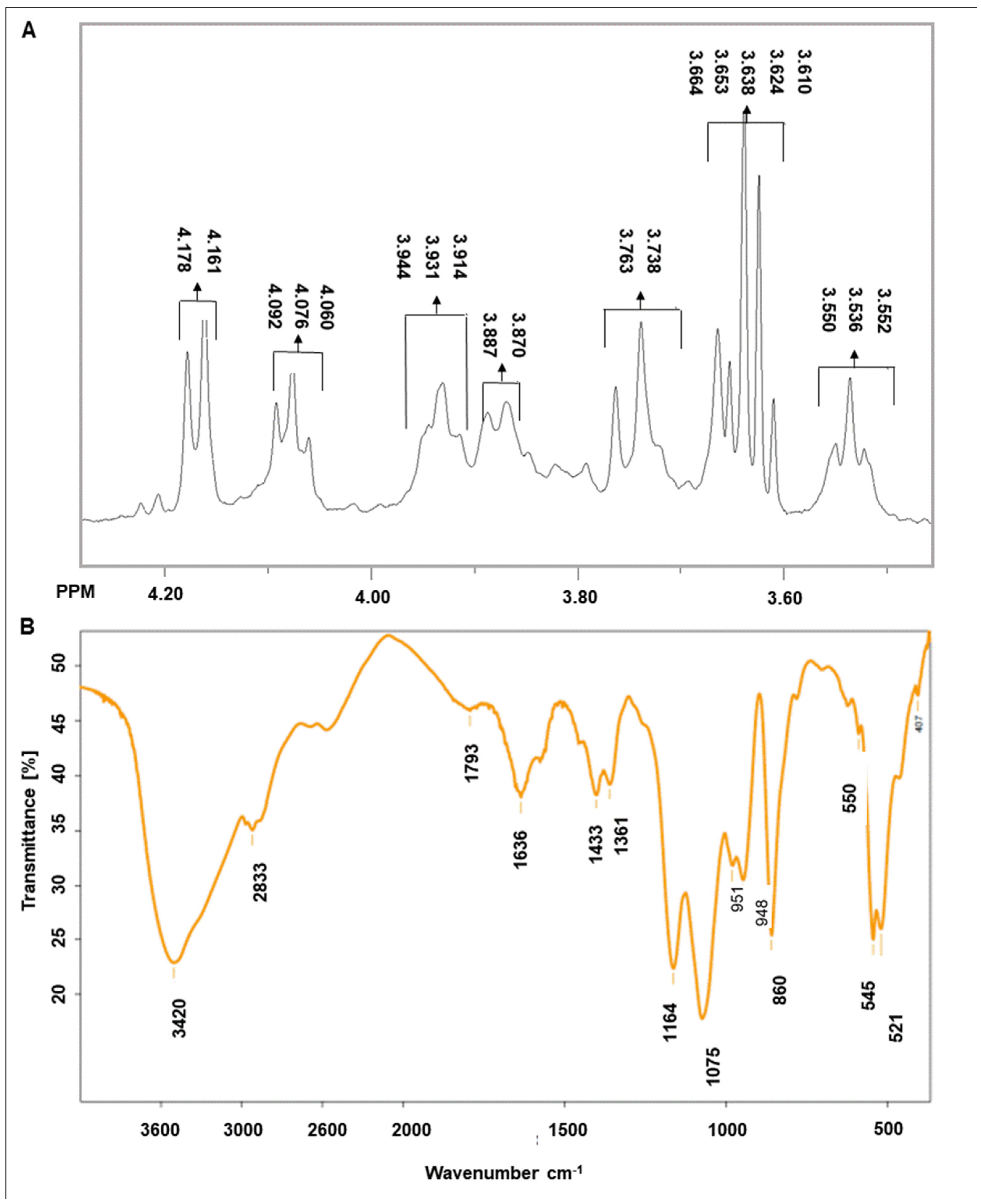




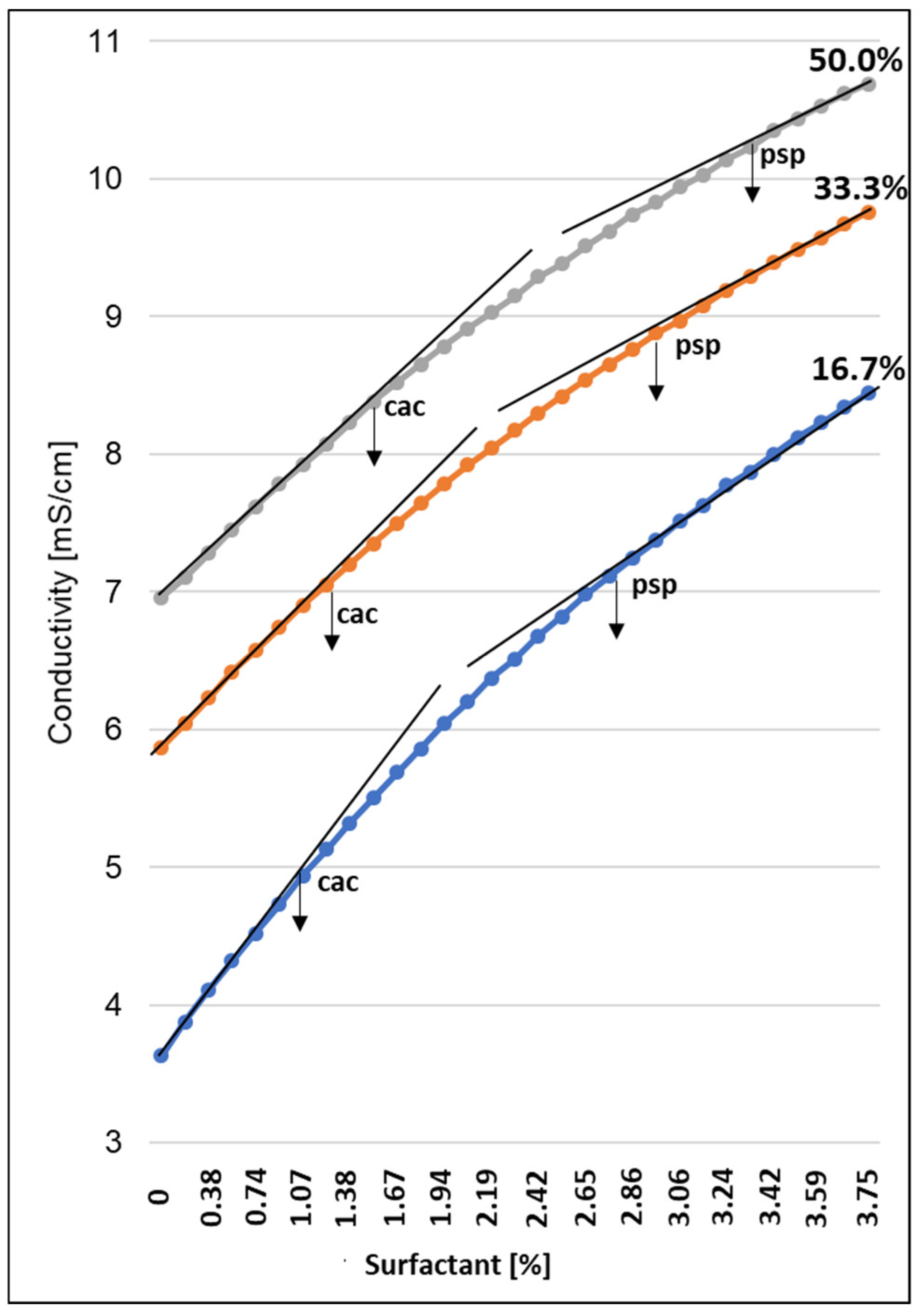
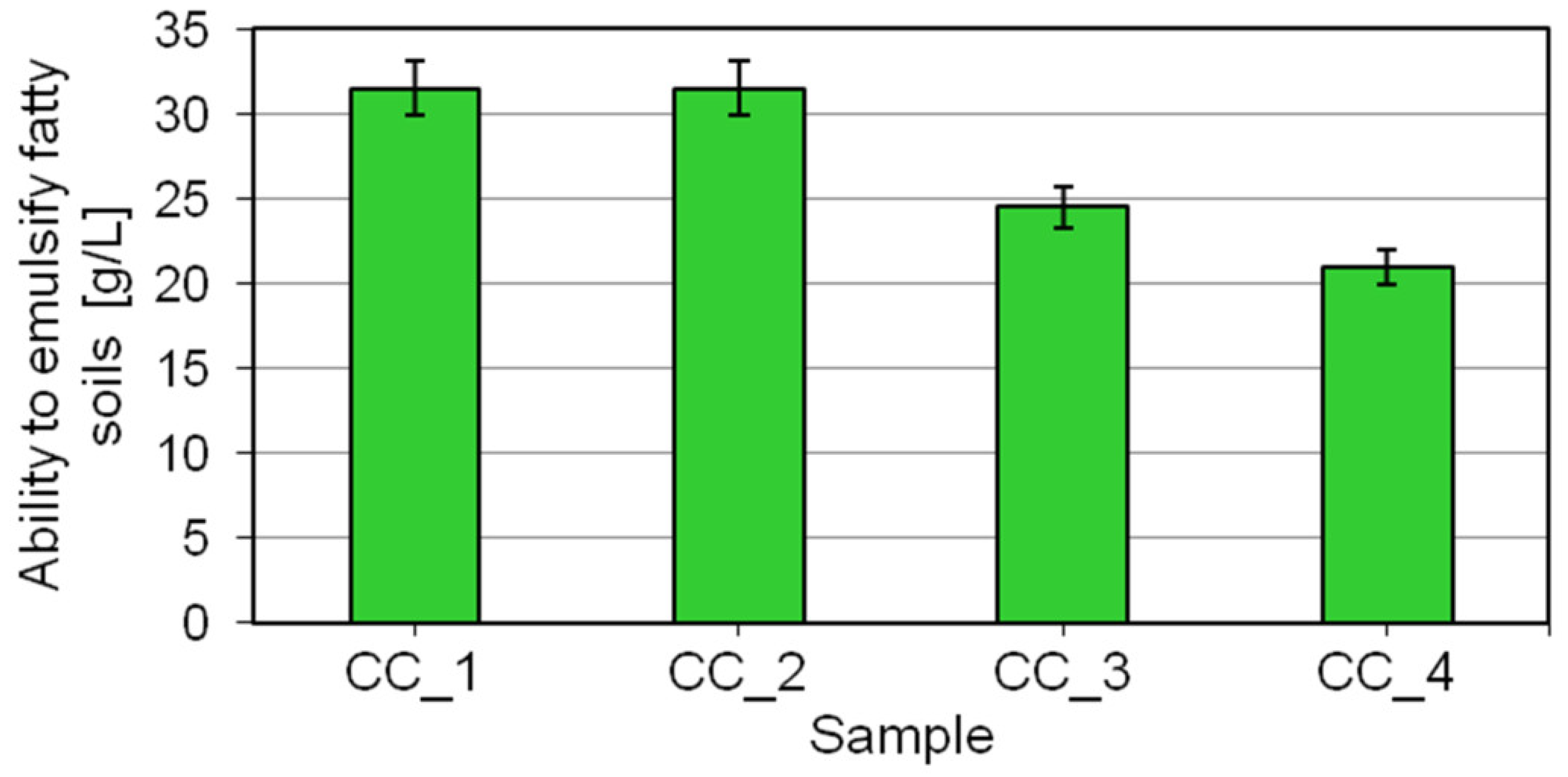
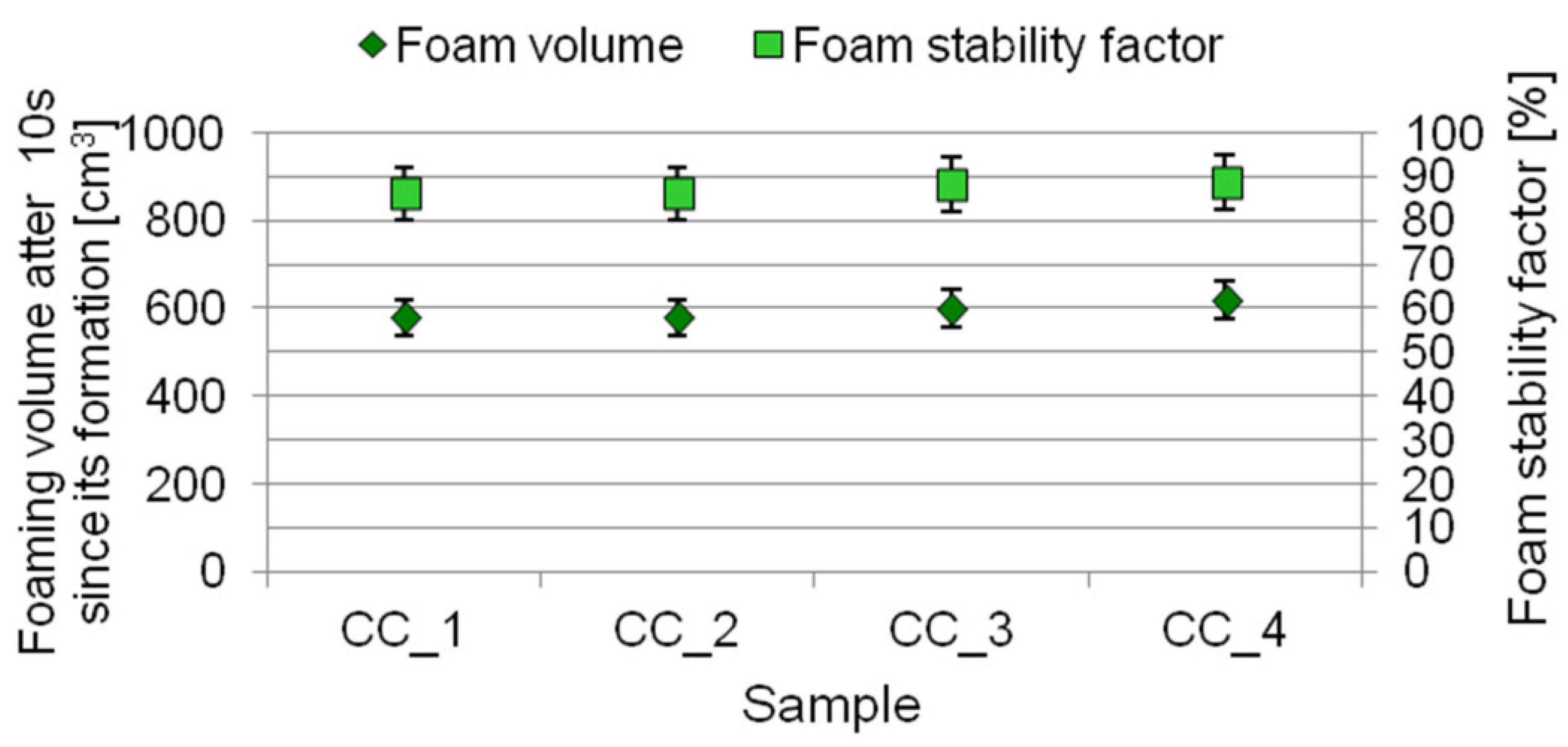
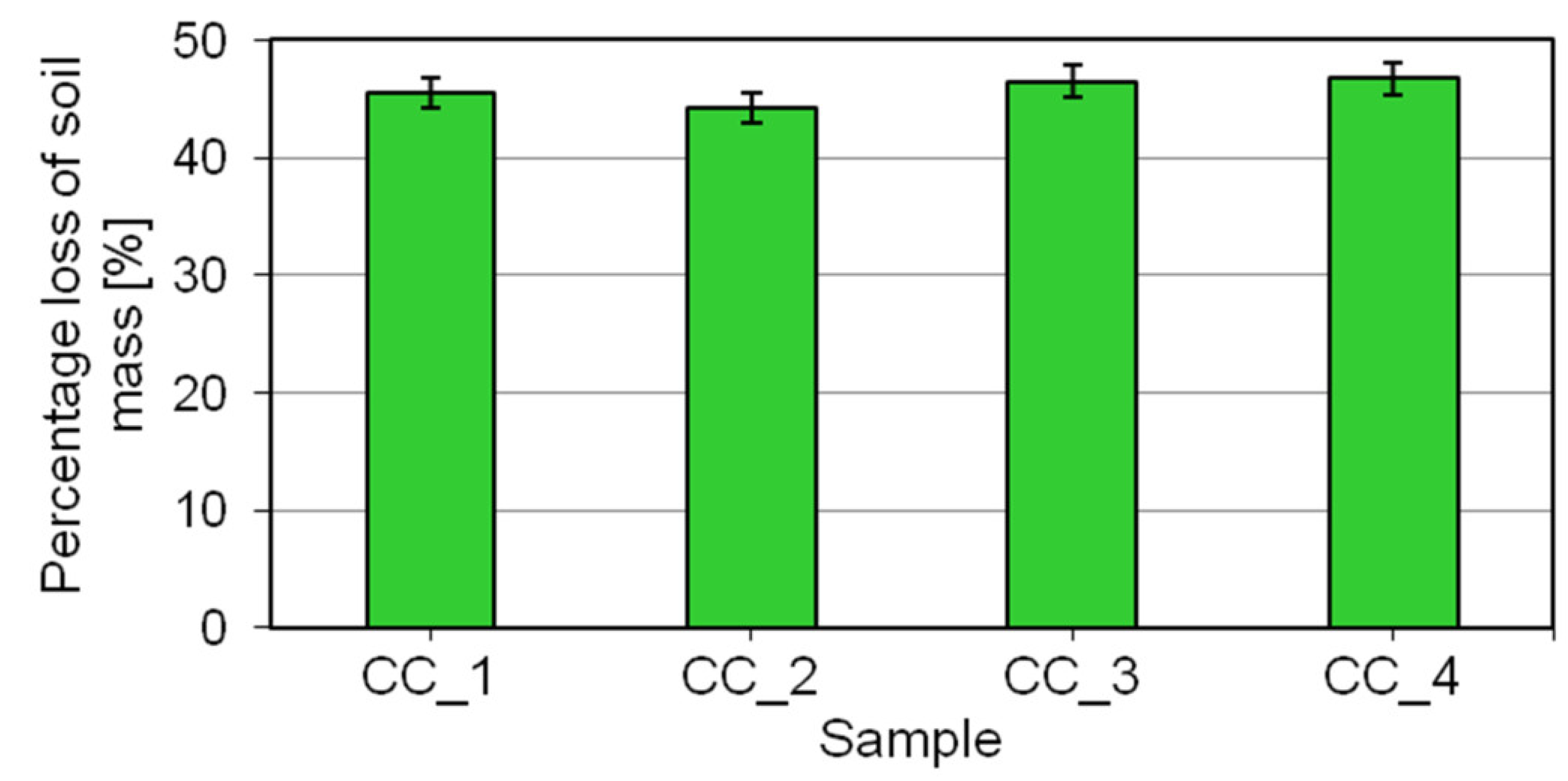
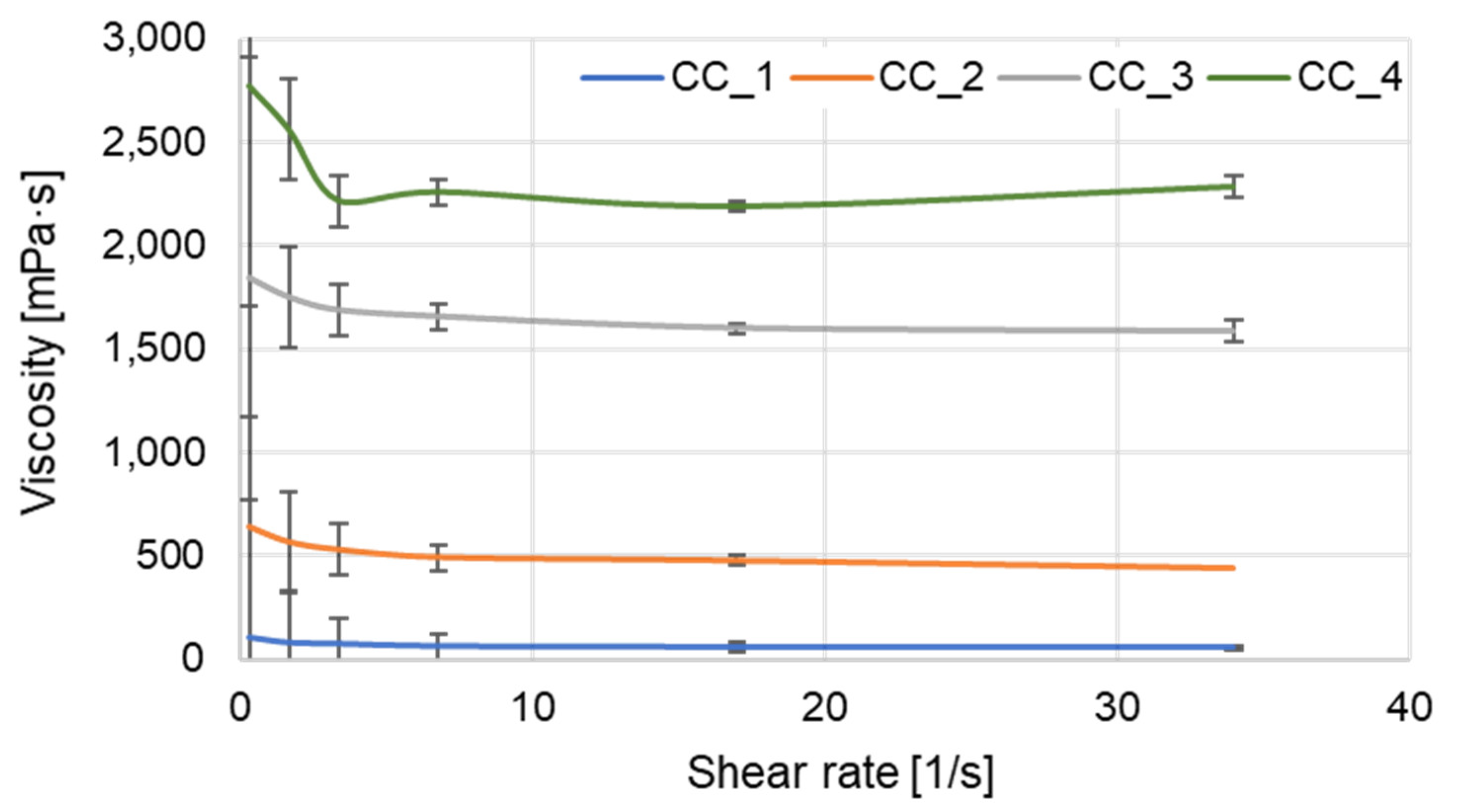

| Pathogen | Inhibition Zone [mm] | MIC Value [mg/mL] | Biofilm * [%] | Adhesion * [%] |
|---|---|---|---|---|
| P. aeruginosa ATCC 9027 | 4.50 ± 1.38 | 275.25 | 92.75 | 53.46 |
| S. aureus ATCC 6538 | 2.83 ± 0.68 | 412.88 | 67.41 | 68.02 |
| S. epidermidis ATCC 1917 | 3.42 ± 0.49 | 412.88 | 92.12 | 72.42 |
| E. coli ATCC 8739 | 2.50 ± 0.84 | 412.88 | 93.16 | 96.97 |
| C. albicans ATCC 10231 | 5.17 ± 0.75 | 206.44 | 76.83 | 70.36 |
| Name According to INCI 1 | CC_1 | CC_2 | CC_3 | CC_4 |
|---|---|---|---|---|
| Aqua | to 100 | |||
| Sodium Coco Sulfate | 3.3 | |||
| Coco Glucoside | 4.2 | |||
| Bacillus Ferment Extract | 0 | 16.7 | 33.3 | 50.0 |
| Cocamidopropyl Betaine | 1.5 | |||
| Citric Acid/ Sodium Hydroxide | do pH 5.5 | |||
| Sodium Benzoate, Potassium Sorbate | 0.45 | |||
| Parfume | 0.5 | |||
| Aqua | to 100 | |||
| L* | a* | b* | C* | ho | ΔEshower gel with digestate extract /base shower gel | |
|---|---|---|---|---|---|---|
| CC_1 | 92.3 | −0.29 | 5.47 | 5.5 | 93.0 | - |
| CC_2 | 93.1 | −0.93 | 4.41 | 4.5 | 101.9 | 1.47 |
| CC_3 | 94.0 | −0.96 | 4.31 | 4.4 | 102.6 | 2.16 |
| CC_4 | 93.5 | −1.00 | 4.76 | 4.9 | 101.9 | 1.56 |
Publisher’s Note: MDPI stays neutral with regard to jurisdictional claims in published maps and institutional affiliations. |
© 2022 by the authors. Licensee MDPI, Basel, Switzerland. This article is an open access article distributed under the terms and conditions of the Creative Commons Attribution (CC BY) license (https://creativecommons.org/licenses/by/4.0/).
Share and Cite
Wasilewski, T.; Seweryn, A.; Pannert, D.; Kierul, K.; Domżał-Kędzia, M.; Hordyjewicz-Baran, Z.; Łukaszewicz, M.; Lewińska, A. Application of Levan-Rich Digestate Extract in the Production of Safe-to-Use and Functional Natural Body Wash Cosmetics. Molecules 2022, 27, 2793. https://doi.org/10.3390/molecules27092793
Wasilewski T, Seweryn A, Pannert D, Kierul K, Domżał-Kędzia M, Hordyjewicz-Baran Z, Łukaszewicz M, Lewińska A. Application of Levan-Rich Digestate Extract in the Production of Safe-to-Use and Functional Natural Body Wash Cosmetics. Molecules. 2022; 27(9):2793. https://doi.org/10.3390/molecules27092793
Chicago/Turabian StyleWasilewski, Tomasz, Artur Seweryn, Dominika Pannert, Kinga Kierul, Marta Domżał-Kędzia, Zofia Hordyjewicz-Baran, Marcin Łukaszewicz, and Agnieszka Lewińska. 2022. "Application of Levan-Rich Digestate Extract in the Production of Safe-to-Use and Functional Natural Body Wash Cosmetics" Molecules 27, no. 9: 2793. https://doi.org/10.3390/molecules27092793






